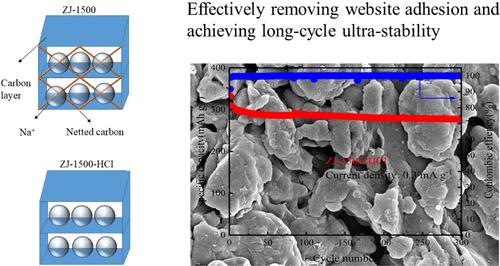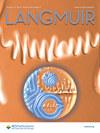Construction of an Anode Material for Sodium-Ion Batteries with an Ultrastable Structure
IF 3.7
2区 化学
Q2 CHEMISTRY, MULTIDISCIPLINARY
引用次数: 0
Abstract
The reserves of sodium resources are much larger than those of lithium resources, and they are widely distributed and easy to produce and can be widely used in photovoltaic energy storage and other industries on the premise of this advantage. However, how to produce hard carbon anodes at a low cost for the preparation of energy storage materials requires continuous exploration and experimentation to find the optimal solution. Here, we used waste sour date shell biomass as a precursor for a hard carbon anode obtained by simple acid treatment and two pyrolyses. It is shown that acid washing after prepyrolysis has a significant effect on the electrochemical performance of the sour date shell-derived hard carbon (ZJ), constructing a stable structure that makes it easier for sodium ions to be embedded and dislodged, and the carbon particles are homogeneous and free of bonding and electrode cracking. The ZJ-1500-HCl pyrolyzed at 1500 °C has a high reversible capacity of 329.1 mAh g–1, 94.1% initial Coulombic efficiency (ICE), 90.54% capacity retention efficiency cycling 300 cycles at a current density of 300 mA g–1, and a resistivity below 10 Ω. It has good cycle stability and a good multiplier performance. It is expected to be used in practical production and photovoltaic energy storage in the future.

构建具有超稳定结构的钠离子电池阳极材料
钠资源储量远大于锂资源储量,且分布广、易生产,在此优势前提下可广泛应用于光伏储能等行业。然而,如何低成本生产硬碳负极制备储能材料,还需要不断探索和实验,寻找最优方案。在此,我们以废弃酸枣壳生物质为前驱体,通过简单的酸处理和两次热解获得了硬碳阳极。结果表明,预热解后的酸洗对酸枣壳衍生硬碳(ZJ)的电化学性能有显著影响,可构建稳定的结构,使钠离子更容易嵌入和脱落,碳颗粒均匀,无粘结和电极开裂现象。在 1500 °C 下热解的 ZJ-1500-HCl 具有 329.1 mAh g-1 的高可逆容量、94.1% 的初始库仑效率 (ICE)、90.54% 的容量保持效率(在 300 mA g-1 的电流密度下循环 300 次)和低于 10 Ω 的电阻率。它有望在未来用于实际生产和光伏储能。
本文章由计算机程序翻译,如有差异,请以英文原文为准。
求助全文
约1分钟内获得全文
求助全文
来源期刊

Langmuir
化学-材料科学:综合
CiteScore
6.50
自引率
10.30%
发文量
1464
审稿时长
2.1 months
期刊介绍:
Langmuir is an interdisciplinary journal publishing articles in the following subject categories:
Colloids: surfactants and self-assembly, dispersions, emulsions, foams
Interfaces: adsorption, reactions, films, forces
Biological Interfaces: biocolloids, biomolecular and biomimetic materials
Materials: nano- and mesostructured materials, polymers, gels, liquid crystals
Electrochemistry: interfacial charge transfer, charge transport, electrocatalysis, electrokinetic phenomena, bioelectrochemistry
Devices and Applications: sensors, fluidics, patterning, catalysis, photonic crystals
However, when high-impact, original work is submitted that does not fit within the above categories, decisions to accept or decline such papers will be based on one criteria: What Would Irving Do?
Langmuir ranks #2 in citations out of 136 journals in the category of Physical Chemistry with 113,157 total citations. The journal received an Impact Factor of 4.384*.
This journal is also indexed in the categories of Materials Science (ranked #1) and Multidisciplinary Chemistry (ranked #5).
 求助内容:
求助内容: 应助结果提醒方式:
应助结果提醒方式:


